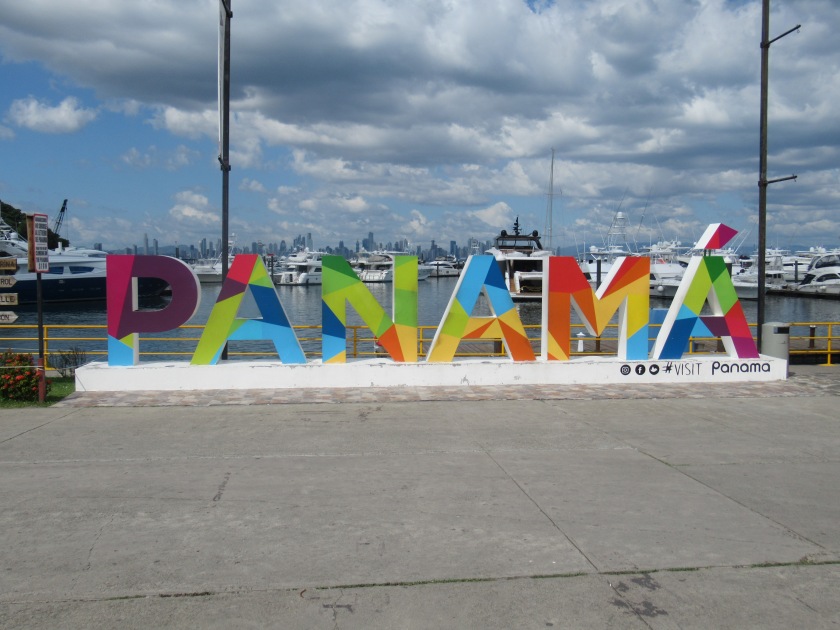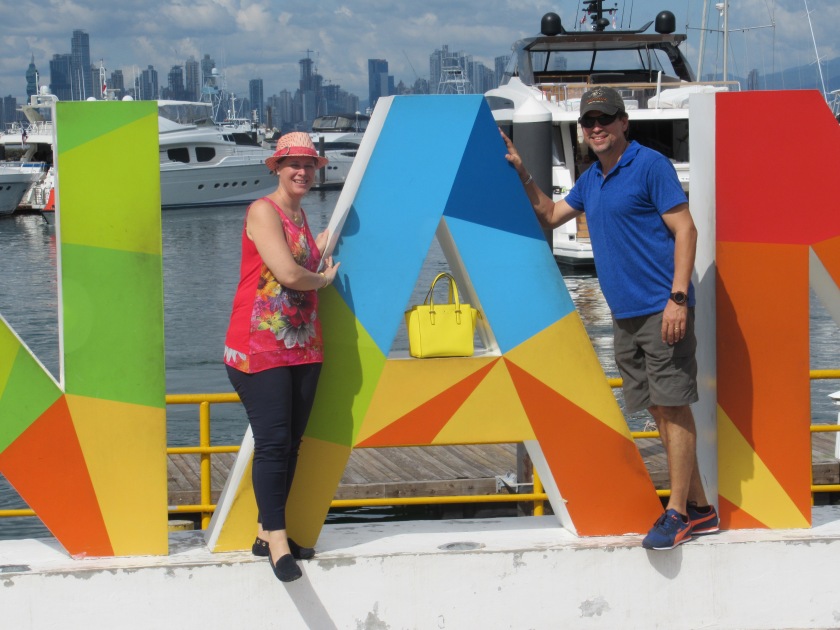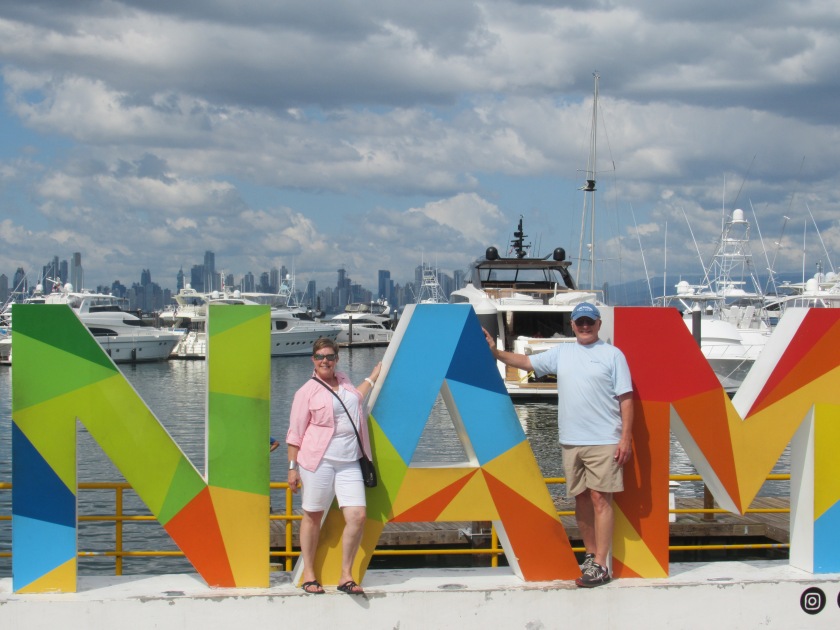
We spent five days in Panama this week. Hope you enjoy these photos and stories.


Two ships waiting to enter the Panama Canal. These were taken from our airplane.


Photos of a portion of downtown Panama City taken from our room, 20 floors up!


Food? Oh yeah. On the left is a bowl of ceviche and an empty dish from hummus. On the right side is a plate of chicken parma.


This is the administration building at the Panama Canal. This model of a ship and dredging equipment is located in the Panama Canal museum.


The ship in the foreground on the left is going through the original portion of the canal. In the background of that photo, and in the photo on the right, is a much larger, faster ship using the newer part of the canal that opened in 2016. The upper part of the canal is made for these larger ships, and has greatly increased the number that pass through every day. I can’t believe how much money each ship pays for the use of the canal, and I bet you won’t either. I’ll leave it to Deb to pass that info on to you.










These buildings are located in a portion of Panama City called Casa Viejo. It is also known as “Old Panama City.” The buildings in this area were all built in the 1600’s and 1700’s. This part of the city was in ruins. Now it is being turned around and is alive and well and becoming popular. Many new shops, restaurants, and clubs are opening up. The structures are not being torn down, but instead they are being completely refurbished and given a new lease on life. The history here is important and people want to preserve it as much as possible.




We toured a village of indigenous people known as the Embera. This is not a made for tourism village, but the actual place where they live. We drove out of the city for an hour, then took a motorized canoe trip for about 15 minutes to reach this site. The river we traveled on is home to crocodiles, caiman, monkeys, toucans, and a variety of other tropical wildlife. There are no cars, trucks, or even bicycles. These photos show the huts of the village as we approached in the canoe, and the Embera welcoming us with a traditional dance.


The chief of the Embera village. He was elected by the people and is very popular. He spent at least 20 minutes with Deb and I answering a multitude of questions. There were easily 20 other tourists there from other groups, but he seemed to want to talk to us and share the history of these people. He never stopped smiling.


This is their Medicine Man with 2 young boys and some fish he had just caught in the river. He was very gracious and friendly towards us. This woman has the title of Queen of the Dance. It is an honor to have been given this title. It is given to the woman who is the best dancer of the village. With the title comes the responsibility of teaching the young children of the village these dances and passing on their history and meaning.






Speaking of dancing! They showed us some of their traditional dances that are used for celebrating such things as births and weddings. There are also celebrations periodically where several villages of these people get together for festivals. These celebrations and festivals are for the Embera people only as they try to keep their customs and traditions alive. As you might have noticed in the pics, this wasn’t one of those special times. Old people were allowed to participate!! It really was fun.


Lunch time. Remember the fish the Medicine Man was carrying? Those two along with fish that other men from the village caught in the river this morning were invited to lunch! How nice. And the plantains the woman just chopped down also came to the feast. How wonderful. The fish and plantains were fried and served in those large leaves, which doubled as the plate. And for dessert? Pineapple, of course. Fresh, juicy and sweet.


Traditional dress when having special visitors or guests. The bead work is beautiful and done by hand, bead by bead.




The children of the village are a joy to watch. They are always playing, running, laughing. Even when some of them ran through the dancers, no adult yelled at them or reached out to stop them. It was sort of understood this is how they begin to partake in and feel a part of the dances. The women do the cooking, harvesting of fruits, and taking care of the children. The men do the fishing, the construction of all of the huts, and protect the village from unwanted animals and reptiles. Both men and women take part in the creative art traditions. The women mainly do bead work and beautiful basket weaving. The beads are an integral part of their jewelry and clothing. The men create carvings from the local wood in the rain forest. There is no sandpaper, oils, varnish, or stains used. I was amazed at how perfectly smooth and shiny some of these pieces were. The men use stones, chisels, and their hands in their craft. Truly amazing.
The man with the three little boys was our guide, Rudy. He has known these three, and indeed most of the young children of the village, since they were born. When we were getting off of the canoe, they came running and yelling his name.
And the little guy practicing his soccer dribbling was so cute. And barefoot (as were all of the Embera). But take a closer look. The soccer ball is actually a coconut!!!! Some older boys were playing with a real soccer ball. He used a coconut. Wimpy older kids. LOL.




This baby toucan has adopted the Embera village. This is certainly not the norm. As the toucan reaches adulthood, it will most certainly leave and take it’s place in the tropics. A few more huts, actually family homes. In the photo on the right are two new huts in different stages of construction.


This spider monkey was just hanging out as we traveled down the river in the canoe. Had to include these pics for our grand kids Cassidy and Lucas, as well as our son Erik. It’s photo ops like this that really make me realize we are living in the tropics this winter.

This is our tour guide Rudy and his lovely wife Patty. We went on two tours with Rudy and can’t put into words how much it enhanced our visit. He led us through the Panama Canal and Old Panama City on one tour. The Embera tour with Rudy was very special. If any of our friends or relatives get to visit Panama, we highly recommend his service. Just google Rudy’s Tours, Panama. Don’t try touring on your own. Too much history and too many places to attempt this on your own. We will probably be going back in March, and will definitely give Rudy a call.

That’s all we did this week! We’ll try to pick up the pace as time goes on so this will be more interesting and informative for everyone! We start getting visitors on Jan 2nd, and both of us are looking forward to sharing our adventure with a number of our friends in the coming months.
Stay happy. Stay warm. I would tell you what the temp was here today, but I don’t want to make our fellow Minnesotans cry. Just know Deb and I are in shorts, tee shirts, and sandals. Every Day. And now, it is Deb’s turn.
Hola, Everybody.
I will give you some facts regarding the Panama Canal, first, as I recall them. The cost of going through the locks at the Canal is $1,000,000 for a large vessel and $400,000, give or take $100,000! $1,000,000! It is much cheaper than having to travel all the way around South America. This is the price each and every time they go through the locks. Approximately 50 ships travel through each day. Ships from the Pacific are allowed through in the morning hours only. In the afternoon, ships sailing from the Caribbean are allowed through. The larger canal was built starting in 2007 and, as Tim said, finished in June of 2016. Many workers from every province had a hand in the building of this canal so when it opened there was much fanfare. Panamanian people are very proud of this accomplishment.
Facts we learned about the “Old City” are that it has, over the past twenty years, been renovated. Previous to that it was occupied by gangs and squatters. When someone buys one of these buildings to renovate, they have to pay a few thousand dollars to the squatters to get them to move out and then the city gives the new owner only two years to renovate it or there are substantial fines. The church that Tim shows was located in another section of “Old City”, dismantled and moved to that spot brick by brick. This is the oldest church in Panama City. The hotel on the bottom with the wreath and decorations is the oldest hotel in the entire country of Panama. It just reopened in the past couple of years. Many weddings are celebrated at that church, and then the entire wedding party and guests gather at the hotel for the reception. There are lovely hotels and private apartments to rent. There is a lot of nightlife. It is a gorgeous part of the city. They even have a grocery store now. The old convent (the two pictures on the next to last row) is used for wedding receptions and other special events. What is so interesting about this building is that when the roof caved in, the flat arch was left standing perfectly fine. So, when the engineers and architects looked at that they decided that Panama doesn’t have earthquakes, so it made sense to choose Panama for the location of a canal connecting the Atlantic and Pacific Oceans. There are still priests living in the newer part of the convent next door and they are working with gang members to get them out of gangs. I don’t believe there are any gangs or members living in Casco Viejo anymore. It is very touristy. We had a wonderful lunch there with Rudy and his lovely wife, Patty. We also bought Panama hats which are actually made in Ecuador! All genuine Panama hats are made in Ecuador.
As for our trip to visit the Embera people, words are not enough. Oh my gosh, was that interesting! They were so warm and generous. We learned that at least two of the young people are going to college in Panama City at night. They go to classes until 10:00 PM, then ride a bus for an hour and then take the canoe back to their camp. They arrive home about 12:00 midnight. We asked them what their plans are after they are done with their schooling. They both said that they will use what they learn and stay with their people. One was studying marketing/business and the other, psychology. In talking with the chief, who is elected by the community for 5 years, we learned that if they like the job he is doing, they will just keep him on if he wants to continue. If they don’t like the job he is doing, they will hold another election after those five years. They like him, so he will stay on. It is very democratic. And, they truly live by the adage “it takes a village.”
The Embera people came to move to this area within the past twenty years due to drug trafficking. They lived near the border of Columbia but drug traffickers were disturbing their way of life and scaring them so they migrated to the Chagras River area. They are river dwellers. They live off the land. The men spear the fish they catch but they get in the water where there are crocodiles and caiman and are never harmed. I asked if the crocs or caiman ever come up on land near their camp. I was told that they know better than to do that. Obviously there is enough food for the animals in the river that they stay away from the village.
The Embera also live into their nineties. I asked what they do with their dead and Rudy said that they take them by canoe to a burial ground where they are buried. They live a very stress-free simple life and they are physically active. Rudy says he has never heard one of the elderly members complain of aches and pains. They are so similiar to our native people and, in fact, have been visited by some from the U.S. They believe in spirits like our native people and they use herbs for medicinal purposes. The Embera believe that every living thing has a spirit. Whether it is a plant, reptile, bird, fish, animal or insect, it has a spirit. They live a clean life. Everyone has smiles on their faces. They are happy people. It was a wonderful experience.
They fed us lunch of tilapia (which tastes way better down here because it isn’t farmed), green plantains that are fried twice and salted sort of like our french fries, and then fresh delicious pineapple and watermelon. The men were busy building a family a new hut. They sleep on mats on the floor and when they wake up, they put them up on a shelf and then the sleeping area becomes their living space. I believe the cooking is all done communally, though I am not sure.
Our time in Panama was so interesting. We never would have learned the history of the Panama Canal, the Old City, or even known about the wonderful Embera people. It was a trip we’ll never forget. Rudy was an excellent guide because he loves what he is doing and loves history. He’s a storyteller. Thanks, so much Rudy.
We hope everyone enjoys our stories and pictures. We certainly enjoy living the stories we are telling and seeing the sights that our photos capture.
Pura Vida,
Deb & Tim.